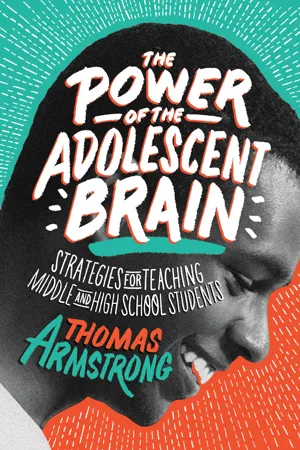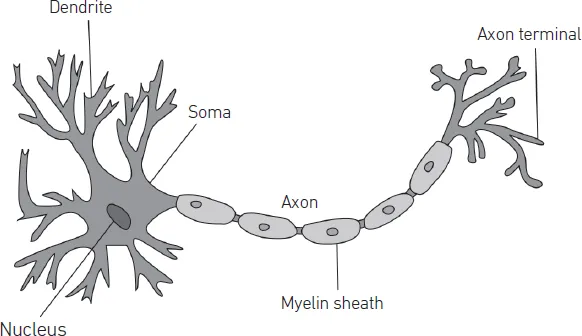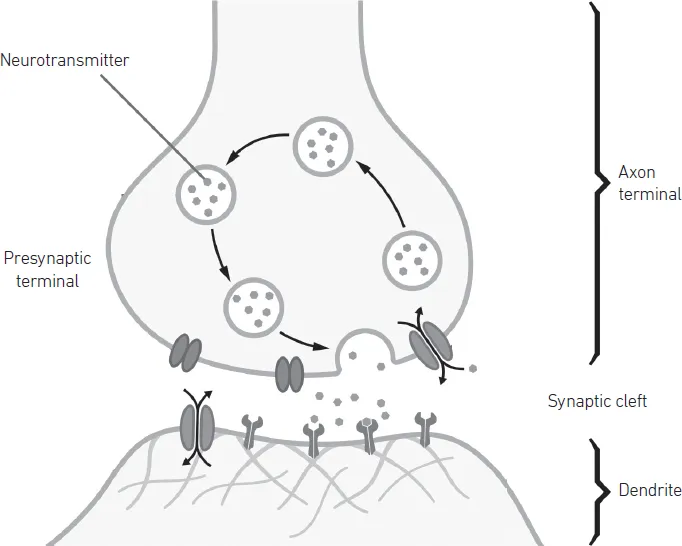![]()
Chapter 1
The Amazing Adolescent Brain
. . . . . . . . . . . . . . . . . . . .
It appears that the brain changes characteristic of adolescence are among the most dramatic and important to occur during the human life span.
—Laurence Steinberg, "Commentary: A Behavioral Scientist Looks at the Science of Adolescent Brain Development," in Brain and Cognition magazine
There has never been a more exciting time to be a middle school or high school educator. New discoveries about the adolescent brain have completely transformed our understanding of how students between the ages of 11 and 18 need to learn in order to be successful in school and function optimally in the world.
As recently as the late 1990s, most scientists regarded the development of the brain as pretty much finished by age 5 or 6. By that age, 95 percent of the brain's volume is complete, and by around age 10, the brain has reached adult size. But during the last 15 years, largely because of advances in neuroimaging technologies, especially those involving structural and functional magnetic resonance imaging (sMRI and fMRI), a whole new picture of the adolescent brain has emerged.
In this chapter, we'll look at some of the major discoveries that have been made about the developing adolescent brain since the turn of the millennium. This survey will help lay the foundation for subsequent chapters' discussions of the educational implications of this research.
Raging Hormones and Beyond
It used to be thought that the erratic behaviors of adolescents stemmed from the "raging hormones" accompanying puberty. It's true that hormones do play a role in driving adolescent behaviors: sex hormones fuel sexual striving, sensitivity to physical attractiveness, and interest in romantic partners. Both estrogen and testosterone (the latter of which increases by a factor of 10 in adolescent boys) appear to organize structural connections in the brain (Arain et al., 2013) and directly affect neurotransmitters (chemicals that travel over the synaptic cleft and help pass information from one neuron to another), shaping brain maturation and cognitive functioning in adolescence (Sinclair, Purves-Tyson, Allen, & Weickert, 2014). However, direct links between testosterone and aggression have been called into question. Recent evidence (Eisenegger, Haushofer, & Fehr, 2011) suggests that testosterone has more to do with the search for and maintenance of social status, which may result in aggression but could also induce other actions, such as bargaining and cooperation.
More important than the specific effects of hormones are the broader developmental changes that occur in the adolescent brain. Perhaps the most fundamental change—and the discovery that seems to have driven us to rethink how the teenage brain works—comes from neuroimaging studies revealing that white matter and gray matter in the brain undergo significant changes during the adolescent years.
White Matter Increases in the Adolescent Brain
White matter in the brain consists primarily of glia and myelinated axons. Glia are cells that create myelin, the fatty protective coating around axons, or the nerve fibers coming out of neurons in the brain. Axons conduct electrical impulses away from the neuron's cell body (see Figure 1.1). When an impulse reaches the presynaptic terminal of a neuron (see Figure 1.2), it helps activate a chemical message (carried by a neurotransmitter) that takes place between brain cells.
Figure 1.1 | Structure of a Neuron
Source: Creative Commons Attribution-ShareAlike 3.0 Unported license. © Quasar Jarosz at English Wikipedia, https://commons.wikimedia.org/w/index.php?curid=7616130.
Think of myelin as wire insulation for axons. An axon that is myelinated can conduct electrical impulses up to 100 times faster than an unmyelinated one. Moreover, myelination allows the axon to recover more quickly after firing—a feature that, combined with the quicker firing, represents a 3,000-fold increase in the nerve fiber's bandwidth. Myelin also helps calibrate the coordination of inputs from other neurons. As Jay Giedd (2009), former chief of the Brain Imaging Section of the Child Psychiatry Branch of the National Institute of Mental Health, puts it,
In order for input from nearby and more distant neurons to arrive simultaneously, the transmission must be exquisitely timed. Myelin is intimately involved in the fine-tuning of this timing, which encodes the basis for thought, consciousness and meaning in the brain. The dynamic activity of myelination during adolescence reflects how much new wiring is occurring. (p. 4)
Advanced imaging techniques confirm an increase in white matter organization during adolescence in regions of the brain associated with cognition and behavior. As a result of myelination, the amount of white matter in the brain increases in a linear fashion throughout adolescence and into the late 20s.
Gray Matter Decreases in the Adolescent Brain
Gray matter refers to the cell bodies of neurons, the nerve fibers that project from them (axons and dendrites), and support cells (see Figure 1.1). Synapses are the structures at the ends of axons and dendrites that allow for the chemical transmission of information from one neuron to the next (see Figure 1.2). When an electrical impulse travels along a neuron's axon, it can activate the flow of neurotransmitters across the synaptic cleft, sending a signal to the dendrite of an adjacent neuron. In this way, information travels from one neuron to another.
Figure 1.2 | Structure of a Synapse
Source: Creative Commons Attribution-ShareAlike 4.0 International license. © Thomas Splettstoesser: www.scistyle.com.
A baby's brain contains almost twice the number of synapses that an adult brain has. After the age of 2 or 3, however, the brain undergoes a process of pruning, which eliminates synapses that are not used or stimulated by the environment. By diminishing the number of connections in the brain, pruning actually results in a more efficient brain, unencumbered by a lot of unnecessary neuronal connections. Think of a gardener pruning a bush, clearing out the dead wood, and creating space for new growth to occur. The process of pruning continues during the elementary school years, particularly in the areas of the brain concerned with sensory and motor functions.
At around the age of 11 for girls and 12 for boys, there is a short period when the amount of gray matter increases again. After this period, during adolescence, the brain undergoes a second round of pruning, during which time the volume of gray matter continues to decrease (Giedd, 2008). During adolescence, the brain may lose 1 percent of its gray matter every year yet maintain the same volume because of a corresponding increase in the amount of white matter.
The Adolescent Brain: Pedal to the Metal Without Suitable Brakes
Most pruning in adolescence takes place in the brain's frontal lobes, especially in the prefrontal cortex. The prefrontal cortex is the area responsible for planning, making decisions, setting priorities, forming strategies, and inhibiting impulses and inappropriate behavior. These activities are often referred to collectively as executive functions. A notable feature of brain development is that both pruning and myelination move in slow waves from back to front. This means that the prefrontal cortex (situated behind the forehead) is the last part of the brain to be pruned and myelinated.
In other words, the areas of the brain that are responsible for decision making, impulse control, and other skills necessary for effective functioning in the world do not reach their peak of efficiency until mid-adolescence. By the age of 15 or 16, an adolescent can pretty much perform as well as an adult in laboratory tests of executive function, with one important caveat: the adolescent can think as maturely as an adult under laboratory conditions, or in what has been termed a "cold" cognition setting—that is, in circumstances where there are no emotions or social interactions or pressures involved. Under conditions of "hot" cognition, where feelings come into play or people who are significant to the individual are involved, all bets are off: the thinking process of the adolescent becomes complicated by these other factors. This distinction is significant because most of an adolescent's life is spent in circumstances involving "hot" cognition contexts.
An important source of this more emotionally and socially diffused thinking process is a set of subcortical (i.e., located underneath the prefrontal cortex) structures that frequently work at cross-purposes with the more rational prefrontal cortex during adolescence. These structures of the limbic system, or "emotional brain," include the hippocampus, amygdala, cingulate gyrus, thalamus, and hypothalamus (see Figure 1.3).
Figure 1.3 | Structures of the Limbic System
Source: Creative Commons Attribution-ShareAlike 3.0 Unported license. © OpenStax College-Connexions website: http://cnx.org/content/col11496/1.6.
Here's a rundown of the roles of these structures:
- The hippocampus is a center of emotion, memory, and certain autonomic functions.
- The amygdala is associated with emotional reactivity and strong feelings, such as anger, fear, and joy.
- The cingulate gyrus is instrumental in processing emotion, learning, and memory.
- The thalamus relays sensorimotor signals to the cerebral cortex and helps regulate sleep and alertness in the brain.
- The hypothalamus links the nervous system to the stress-sensitive endocrine system and plays a key role in the initiation of puberty.
While the limbic system finishes developing around puberty, pruning and myelination of the prefrontal cortex proceed more slowly and continue into late adolescence and even into the 20s. It might be helpful to think of the limbic system as an accelerator propelling a car along the highway, and the prefrontal cortex as the car's steering wheel and brakes. Because of the gap in the timing of the development of these two systems, adolescence is a time when the accelerator is being pushed down to the floor while the brakes have yet to be fully installed. Figure 1.4 provides a comparison of the functions of the limbic system and the prefrontal cortex.
Figure 1.4 | A Tale of Two Brain Systems
Limbic System
Mostly developed by early adolescence.
Functions include
- Risk taking.
- Motivation.
- Hunger.
- Sleep cycle.
- Long-term memory.
- Sensation seeking.
- Reward seeking.
- Novelty seeking.
- Impulsivity.
- Primacy of emotional expression.
- Immediate needs.
Prefrontal Cortex
Mostly developed by mid-adolescence, but the capacity to function smoothly with the limbic system and other parts of the brain doesn't mature until the early 20s.
Functions include
- Decision making.
- Planning.
- Working memory.
- Prioritizing.
- Inhibiting impulses.
- Reflecting.
- Organizing.
- Strategizing.
- Self-control.
- Coordinating thought and emotion.
- Delaying gratification.
Research conducted during the last 15 years supports the finding that adolescent decision making, reasoning, planning, and other forms of deliberative thinking do not function as optimally as the thought processes of adults. fMRI scans have revealed that when adolescents are shown photos of people with fearful expressions, the amygdala is activated, whereas in adults it's the prefrontal cortex that is activated (Casey, Jones, & Hare, 2008). This suggests that in social contexts involving strong feelings, adolescents may be more emotionally reactive and less capable of relying on rational faculties.
Rewards and Risks Bring Adolescent Highs and Lows
Teenagers also have a different neural pattern in seeking pleasure and reward than either adults or children. In one experiment conducted at Cornell University (Galvan et al., 2006), scientists offered subjects being scanned in an MRI machine a small, a medium, or a large reward after successfully completing the task of identifying a photo's orientation. When the adolescents received a large reward, the nucleus accumbens—an area in the brain associated with aversion, reward, pleasure, motivation, and reinforcement learning—responded more dramatically than did the same area in children's or adults' brains. But when the teens were offered a small reward, their nucleus accumbens activation decreased to a level below that of children and adults, and their prefrontal cortex displayed a more diffused pattern than that of either of the other two groups. These results suggest that adolescents are primed for big rewards...



